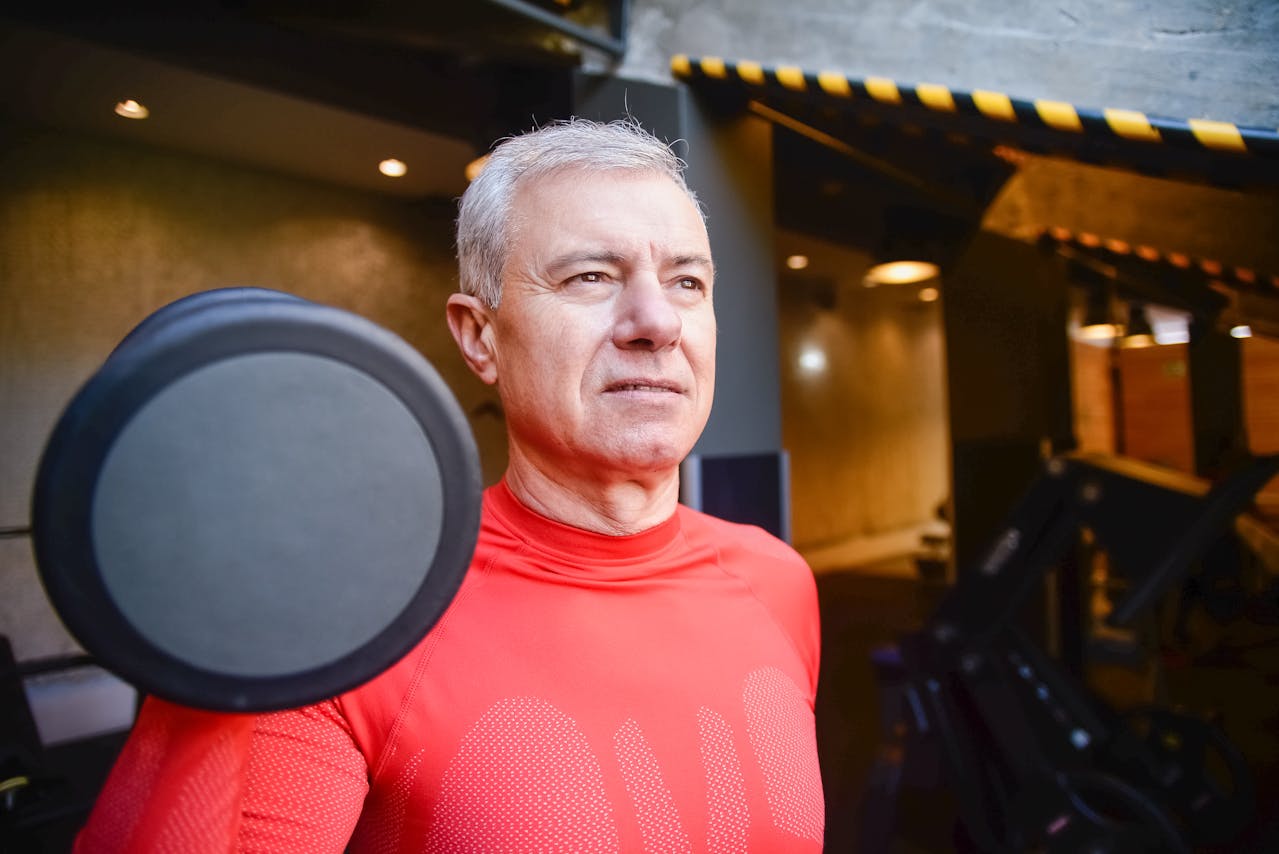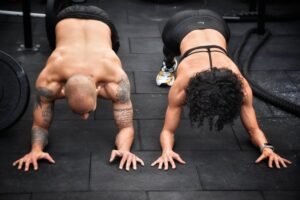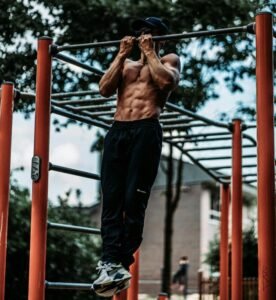Last Updated on November 6, 2025 by shawnshealth
Boost strength, balance, and fat loss with these 5 senior fitness workouts. Stay active, healthy, and independent!
Unlock Strength and Longevity with These 5 Senior Fitness Workouts
Staying active is key to maintaining strength, mobility, and independence as you age. Senior fitness workouts help improve balance, boost heart health, and prevent muscle loss—enhancing both quality of life and longevity. Whether you’re starting fresh or refining your routine, these five workouts will keep you moving with confidence.
🧠 New to senior workouts or need a refresher? Before diving into these exercises, make sure you understand the 15 essential senior fitness principles—they’ll help you build strength, mobility, and confidence safely and effectively.
How Do Senior Fitness Workouts Benefit the Body?
- Builds Strength: Maintains muscle and mobility.
- Boosts Endurance: Supports heart and lung health.
- Enhances Balance: Reduces fall risk.
- Improves Flexibility: Keeps joints pain-free.
- Supports Independence: Makes daily tasks easier.
How Do Senior Fitness Workouts Improve Longevity?
- Strengthens Muscles: Reduces risk of falls.
- Enhances Mobility: Keeps joints flexible.
- Boosts Heart Health: Supports circulation and endurance.
- Maintains Independence: Improves daily movement.
- Supports Mental Well-Being: Reduces stress and boosts mood.
Why Are Senior Fitness Workouts Important?
- Prevents Muscle Loss: Preserves strength with age.
- Improves Balance: Reduces fall risk.
- Increases Energy: Fights fatigue and stiffness.
- Supports Bone Health: Helps prevent osteoporosis.
- Enhances Quality of Life: Promotes overall well-being.
🛒 Looking to upgrade your home fitness setup? Explore top-rated gear that supports strength, mobility, and safe progression—perfect for calisthenics and senior-friendly workouts. From resistance bands to step platforms, these tools can help you stay consistent and confident.
⚠️ As an Amazon Associate, I earn from qualifying purchases—at no extra cost to you.
🎥 Starting out? Watch this quick video from Physical Therapy Session for easy, beginner-friendly moves to get you going.
Table of Contents
As an Amazon Associate, I earn from qualifying purchases. This means I may receive a commission if you purchase through links on this site, at no extra cost to you.
Always consult your doctor before starting any new exercise program. The author is not responsible for injuries or health issues arising from the use of this information.
Author’s Note: Sets and Reps for Senior Fitness Workouts
In each of these exercises I have placed a suggested number of repetitions (a repetition is a single movement of an exercise. example: 1 push-up) however this is not carved in stone. I suggest 3 sets (a group of repetitions. example: 8 push-ups) but you don’t have to do that number. You can do more, or you can do less. Just maintain a regular routine. Example: Move from 3 sets of 5 reps, to 3 sets of 6 reps as you progress, or focus instead on 2 sets but work to a higher number of reps. Do whatever works best for you. Experiment but then stick to a program.
Let’s dive into five practical workouts that can help seniors reap these benefits!
💪 Want to age strong and stay independent? Learn how strength training boosts muscle, bone health, and longevity in this expert guide from Mayo Clinic: Strength training for overall health and longevity
The Movements
1. Supported Squats
What It Does:
Supported squats are excellent for strengthening the legs, hips, and core while improving stability and mobility.
How to Do It:
- Stand in front of a wall, chair, or counter for support, with your feet shoulder-width apart.
- Hold onto the support lightly and slowly lower your body by bending your knees and pushing your hips back.
- Lower yourself as far as is comfortable, ensuring your knees don’t extend past your toes.
- Press through your heels to return to a standing position.
- Repeat for 10–12 repetitions.
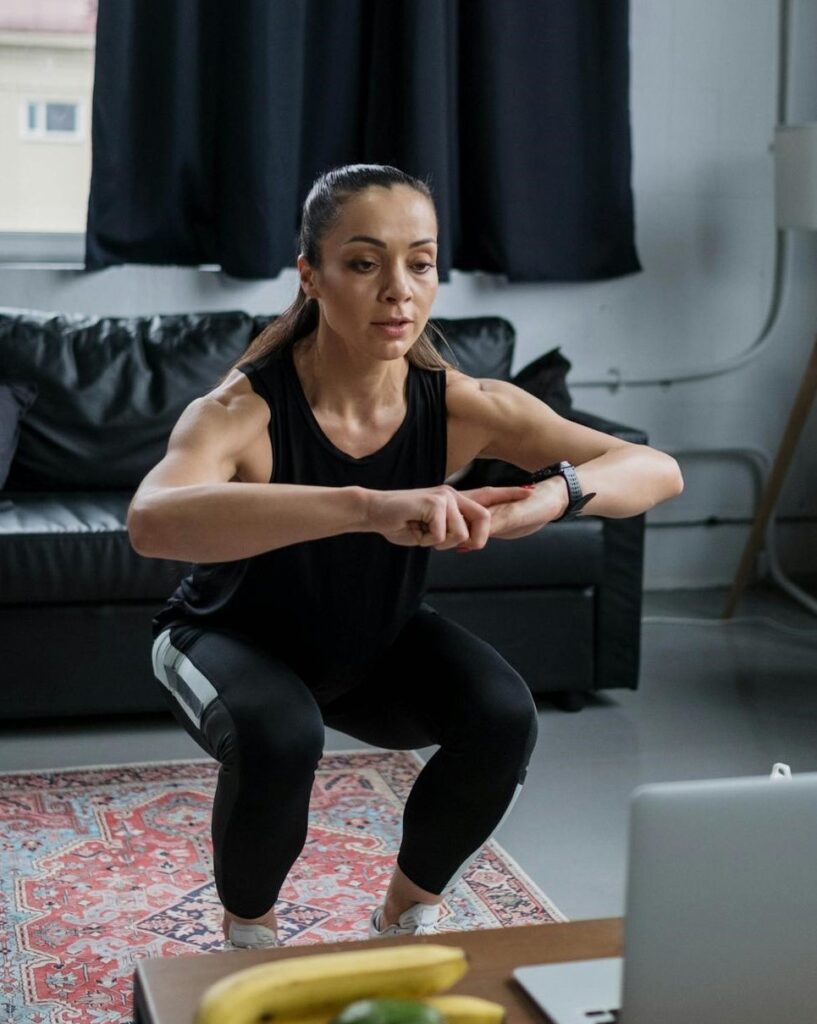
This image represents a very good squat with thighs parallel to each other and to the floor. This is what you want to work towards. A supported squat is simply this with one or both hands using a wall, chair, counter, or any elevated surface to assist with balance and a little help if needed. You don’t have to start out this low. Just go as low as you can, even if just a few inches. Gradually, over time, you may find that your body will tell you when it’s time to go lower simply because it will be easier to do so.
🔥 Want stronger, more stable legs? Check out my guide on 7 Powerful Leg Exercises Without Weights for safe, effective moves that build strength and mobility—no equipment needed.
2. Dumbbell Rows
What It Does:
This upper-body exercise strengthens the back, shoulders, and arms, improving posture and reducing back pain. Resistance bands can be substituted for dumbbells for a lower-impact option.
How to Do It:
- Stand with your feet shoulder-width apart, holding a dumbbell in your right hand.
- Place your left hand on a sturdy chair or bench for support.
- Bend slightly at the hips, keeping your back straight.
- Pull the dumbbell toward your torso by bending your elbow, squeezing your shoulder blade as you lift.
- Slowly lower the dumbbell back to the starting position.
- Complete 10–12 repetitions on each side.
3. Glute Bridges
What It Does:
Glute bridges strengthen the glutes, hamstrings, and lower back, improving core stability and hip mobility.
How to Do It:
- Lie on your back with your knees bent and feet flat on the floor, hip-width apart.
- Place your arms at your sides, palms facing down.
- Press through your heels and lift your hips toward the ceiling until your body forms a straight line from shoulders to knees.
- Hold for a second, then slowly lower your hips back to the floor.
- Repeat for 10–12 repetitions.
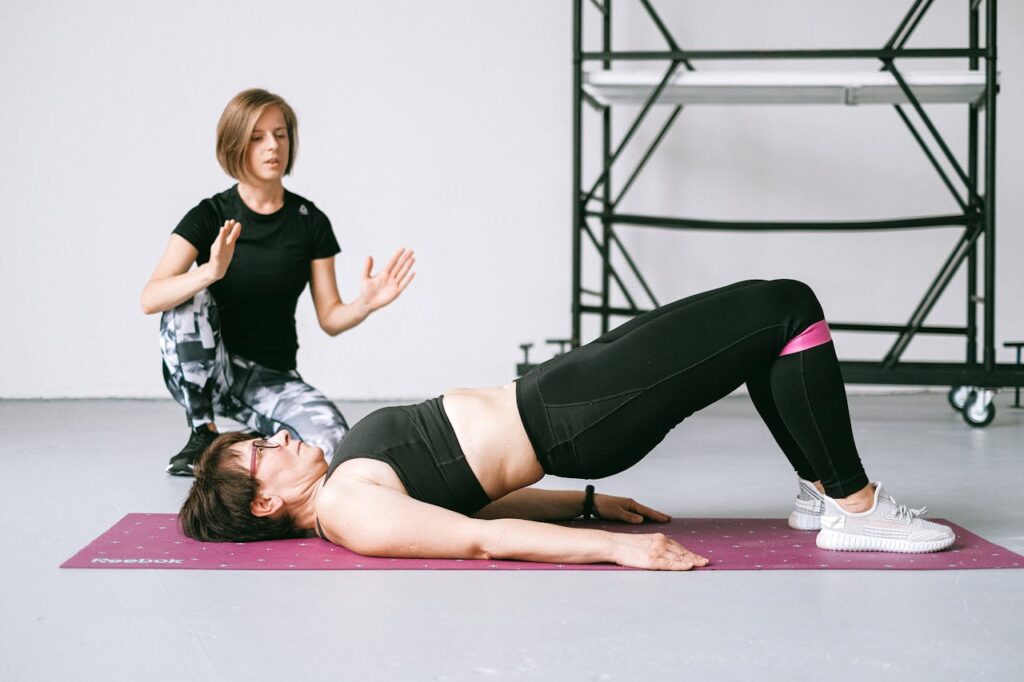
The person in this image is doing this exercise properly. Be sure not to overextend. Keep everything straight before returning back down. You may see this move being done by super flexible people and it seems they can bend backwards in half. That’s not what we are doing. We are strengthening the posterior or back side of our body. Just keep it straight.
4. Step-Ups
What It Does:
Step-ups build leg strength and improve balance, coordination, and cardiovascular health.
How to Do It:
- Stand in front of a sturdy step or low platform.
- Step up with your right foot, then bring your left foot to meet it.
- Step back down with your right foot, followed by your left.
- Repeat for 10–12 repetitions per leg.
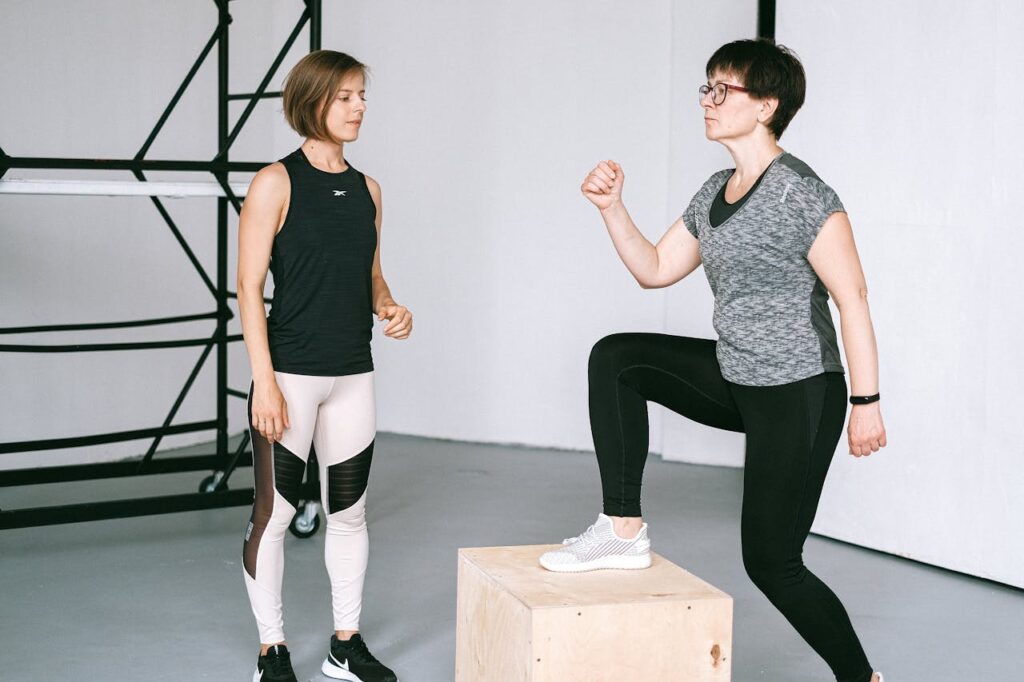
Try not to use momentum but only use your strength to do the step up. I suggest starting with a box or step that is smaller than the one in the image. 6 inches or less might be a good starting point. Then as you become stronger graduate to a higher box/step.
5. Modified Push-Ups (Wall or Counter)
What It Does:
Push-ups target the chest, shoulders, triceps, and core, helping build upper body strength safely.
How to Do It:
- Stand facing a wall or counter, with your hands placed shoulder-width apart on the surface.
- Walk your feet back slightly to create an angled body position.
- Bend your elbows and lower your chest toward the wall or counter, keeping your body straight.
- Push back to the starting position.
- Repeat for 8–12 repetitions.
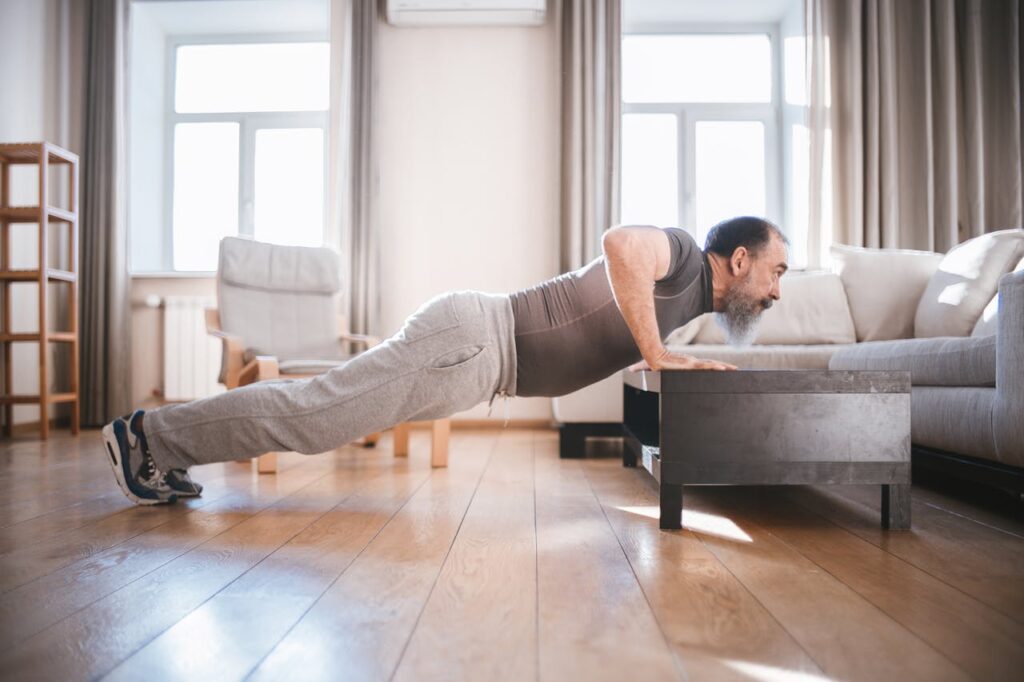
In order to get started you can begin by placing your hands on a wall, a counter, coffee table, or anything else that works for you. If you haven’t done these in a while start at an “easy” progression (like a wall), then, after doing 3 sets of 8 – 12 reps, move to a lower surface. Just keep at it.
Tips for Safe Senior Fitness
- Start Slow: Begin with lighter intensity and fewer repetitions, gradually increasing as your strength improves.
- Warm Up and Cool Down: Spend 5–10 minutes warming up with light movements like walking or arm circles. Cool down with gentle stretching to improve flexibility.
- Listen to Your Body: Stop immediately if you feel pain or discomfort.
How Senior Fitness Supports Fast Fat Loss
Combining strength training with aerobic exercises like walking or swimming can accelerate fat loss in seniors. Muscle burns more calories than fat, even at rest, meaning building strength directly boosts metabolism. To enhance results, pair these workouts with a balanced diet rich in lean proteins, whole grains, and healthy fats.
🤸♂️ Ready to build real-world strength without equipment? Learn how Calisthenics Strength Training can boost your fitness and mobility with safe, effective bodyweight exercises designed for seniors.
Final Thoughts
Staying active through senior fitness is one of the best investments you can make in your health and longevity. These five workouts are safe, effective, and adaptable, ensuring you can build strength, burn fat, and stay independent for years to come.
💪 Ready to take control of your health and longevity? Visit Shawn’s Health
for trusted, progression-aware fitness guidance. Start with the 15 Essential Senior Fitness Principles
to build a safe, effective foundation—then level up with the Unlock Farmer Strength blueprint for real-world power and independence.
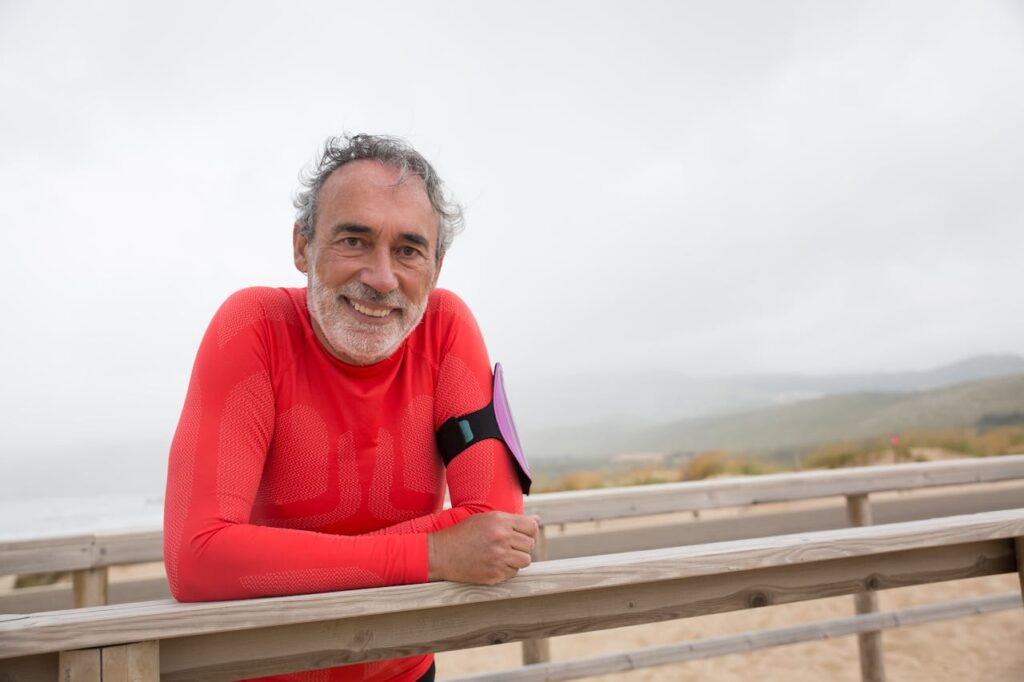
🔥 Gear to Help You Achieve Your Health and Fitness Goals 💪
If you’re looking for tools to enhance your fitness journey, check out this. Explore top-rated fitness gear on Amazon to enhance your workouts. Check out the latest picks here! 🛒 to support your workouts and progress.
🚀 Find equipment designed to boost strength, endurance, and overall performance!
⚠️ Short disclaimer: As an Amazon Associate, I earn from qualifying purchases.
🧠 FAQ: Senior Fitness Workouts
1. Why are fitness workouts important for seniors?
- Improve strength, balance, and mobility
- Reduce fall risk and support independence
- Boost energy and overall well-being
2. How often should seniors exercise?
- Aim for 150 minutes of moderate activity weekly
- Include strength, balance, and flexibility work
3. Can seniors build muscle after 60?
- Yes—consistent strength training preserves and builds muscle
- Helps maintain posture, endurance, and joint health
4. What if I have joint pain or health conditions?
- Start with low-impact movements
- Always consult your doctor before beginning a new routine
5. Do I need special equipment?
- No—bodyweight moves like squats and push-ups are effective
- Optional gear: resistance bands, light dumbbells, sturdy step
6. How do I know if an exercise is too hard?
- If it causes pain or strain, scale it down
- Try wall push-ups or supported squats as easier progressions
7. What’s the best way to warm up and cool down?
- Warm up: light walking, arm circles, gentle movement
- Cool down: slow stretches for hips, legs, and shoulders
8. Can these workouts help with fat loss?
- Yes—strength training boosts metabolism
- Combine with walking and a balanced diet for best results
Be strong and let your heart take courage, all you who wait for the Lord. – Psalm 31:24

